Revisiting The OnePlus 3: sRGB, Memory Management, & More
by Brandon Chester on June 30, 2016 3:00 PM EST- Posted in
- Smartphones
- OnePlus
- OnePlus 3
Display Accuracy
As I mentioned in my initial review, the OnePlus 3 targets the NTSC color gamut. I really feel the need to reiterate that this choice of gamut target makes absolutely no sense. The actual NTSC gamut was never really relevant, even back in the 1950s when it was created. This is because the phosphors used in CRT displays of the time simply could not produce such saturated colors with an adequate brightness level. In fact, most modern displays still cannot realize the original NTSC gamut. Because of this, it was assumed that content was created and should be displayed using the gamut defined by the SMPTE C specification, which is actually smaller than the sRGB gamut. SMPTE C also used CIE Illuminant D65 for the white point instead of CIE Standard Illuminant C which has a CCT of 6774K, making it more blue than the white point used in more modern color standards.
If the NTSC gamut is not a sensible target, a good question is what gamut would be? This gets back into the discussion of color management, which is something I've discussed in the past several times and don't want to tread over again in this article. In theory, it would make most sense for OnePlus to target the DCI-P3 gamut, because right now UltraHD Bluray content uses that color gamut in a Rec. 2020 container for future compatibility as displays actually move to Rec. 2020. That is why Apple is targeting the DCI-P3 gamut on their newest devices, and it's why all the high end UltraHD TVs launching this year use it as well.
Unfortunately, Android poses a problem here. Android has no color management at the system level, and so if you ship a wide gamut display you get oversaturation when viewing anything designed for sRGB, which for most people will include every single piece of content on their phone. Because of this, the only two reasonable options are to just constrain your Android smartphone to sRGB completely, or to include separate color modes that allow switching between sRGB and the wider gamut. This isn't the fault of the Android device makers, and it's clear that the inclusion of wider gamut displays is done with good intentions, but for now we have to wait on Google to bring color management to Android.
One thing I didn't do in my review was test the OnePlus 3 against the NTSC standard. Again, I feel this is mostly pointless because you will not be able to find any content anywhere that targets that gamut, but examining how well the display conforms to OnePlus's target gamut would have been an interesting exercise nonetheless. Unfortunately, OnePlus seems to have changed the white point in the normal display mode significantly with this update, which means any results I report won't be representative of how the phone was on its original firmware, or how it may be in the future. We ran into this same issue with the OnePlus One, where later updates completely changed the calibration and made it much less accurate. OnePlus has a bit of a track record of changing key device behavior after release, with another example being the browser detection on the OnePlus 2 which shut off the A57 cluster. I'm not a fan of publishing results that are subject to change with any update, and I'm not going to play the game of testing a phone again after every single update to see if things have changed, especially when changes are made but not documented at all in the update notes.
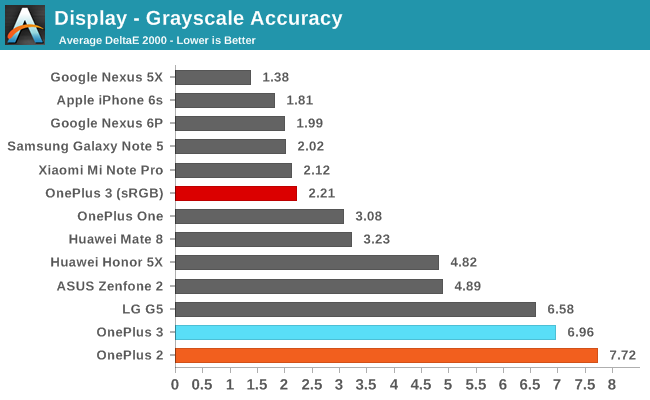
Greyscale accuracy with the sRGB mode enabled is a huge improvement over the standard display mode. The CCT average is slightly below target, but only by a tiny amount. My only complaint is that the RGB balance with the whitest shades is shifted too far toward red, and it would be good to tweak this a tiny bit to make sure 100% white is properly balanced so that the display doesn't have any sort of warm cast on webpages and in Material Design applications. Even with that, the error levels for each individual shade of grey are all at or below three, which is what we're targeting. With these changes the OnePlus 3 goes from being one of the worst displays on record to one of the best, and that's a great thing to see.
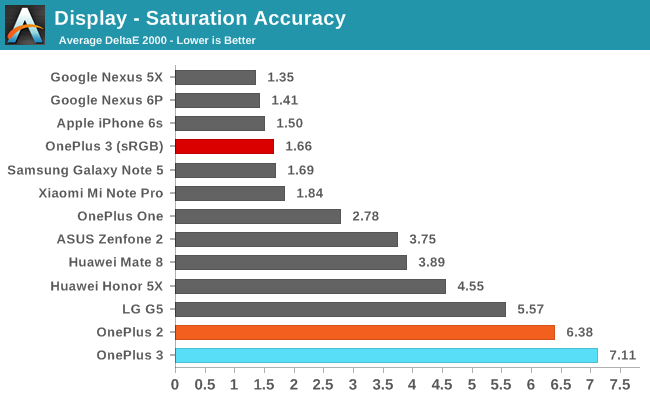
I was originally concerned that it might be too late to properly fix the OnePlus 3's display once phones had shipped, as there's a degree of variance from display to display. However, it appears that the displays, while inaccurate, were defined well enough that OnePlus knew what to tweak to constrain them to sRGB. In the saturation sweep test you can see that only two error values go slightly above three, with the rest being comfortably below.
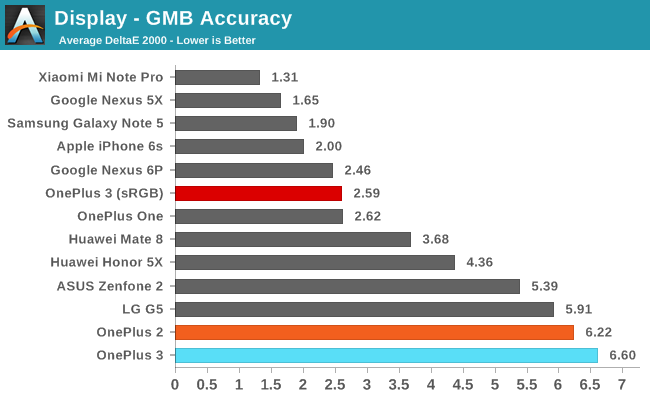
With great greyscale and saturation rendering you're usually set for accurate color mixture rendering. With its sRGB mode enabled the OnePlus 3 does a great job of rendering the colors that are part of the GretagMacbeth ColorChecker test. The error value is below our target value of three, and pushing accuracy much further doesn't bring many benefits as at this point you already can't discern the difference between the colors and their actual reference colors unless you have them sitting still beside one another.
To say that OnePlus's new sRGB mode provides a substantial improvement in display accuracy would be an understatement. The display has gone from being the most inaccurate display that I've seen in years, to being among the most accurate displays that we have on record. Gone is the ghastly blue shift, and even in the standard display mode OnePlus has toned that down significantly. The gamut matches sRGB very well, and both greyscale and color reproduction is right on target.


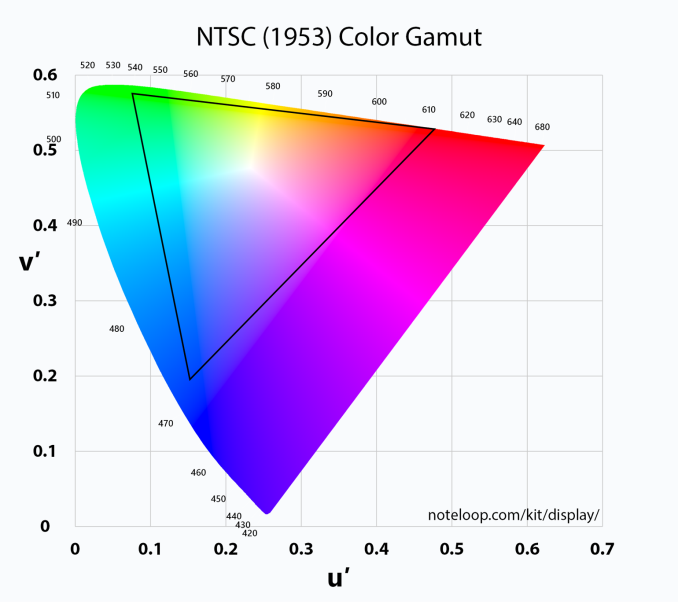
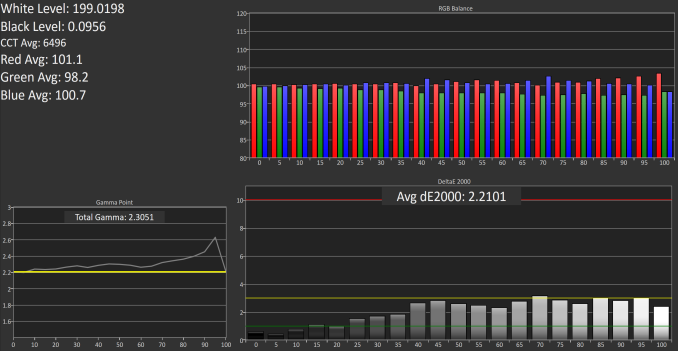

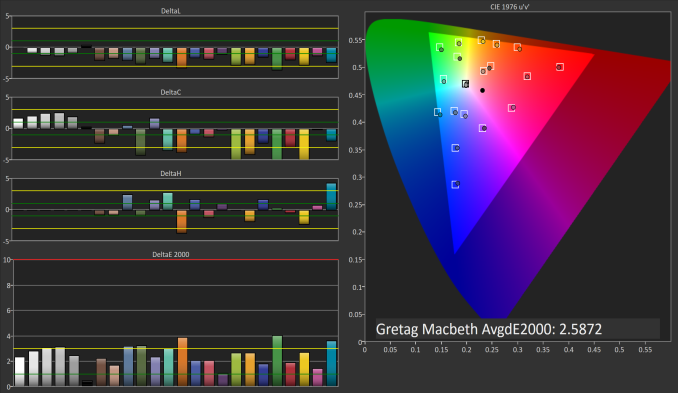








81 Comments
View All Comments
zepi - Thursday, June 30, 2016 - link
The question is: Is there any real need for device specific calibration if they can just ship a updated colour profile and hit well within "good enough" territory without worrying about device level differences?I wonder if someone could test 20 "identical" OLED phones and 20 identical LCD phones / displays and see if there are any real variations?
Brandon Chester - Thursday, June 30, 2016 - link
I sure wish that we could, but getting more than one device is already very difficult, let alone twenty.It's also worth noting that backlight variance probably makes post-ship changes more difficult on LCDs than on OLEDs.
JanSolo242 - Thursday, June 30, 2016 - link
It would be interesting to know what impact the memory management changes have on battery life, if any.jjj - Thursday, June 30, 2016 - link
Maybe you should have loaded a couple of big games too.Memory management seems to be all over the place and people care about it so including details on it in reviews might not be a bad idea.Would also like to make a case for a 360 Mobile N4 review. Not that i expect you guys to review such a device since you are too commercial to review what's interesting instead of what's in the financial interest of the owner.
Still, you got a 135$ device with 2xA72@ 2.1GHz and 8 more little cores pedaling behind , 4GB of RAM, a GPU that seems sufficient for 1080p gaming ( once again AT really needs to start testing the GPU in actual games at some point this century) and it makes one wonder how much sense does it make to pay 2 to 5 times more on a SD820 device.Sure you get better cam and wifi and other little bits but for a few years midrange was little cores and there was a huge theoretical perf gap.Theoretical because even A53 at high clocks results in a decent experience. Helio X20 and even SD65X changed the landscape in a substantial way and no publication seems to be willing to notice and take a look at that.
Yesumanu - Thursday, June 30, 2016 - link
I would refrain from calling Anand "too commercial" when they're reviewing niche devices like this:http://www.anandtech.com/show/9868/cubot-h1-smartp...
To comment on the phone you have mentioned, it does not have a stellar price/performance ratio. It costs $135 in China, if you're an international buyer be ready to pay $200 for it, and for that price you are better off with the Meizu Note 3 with Snapdragon 652, metal chassis and software support (this "360" company update record is either sketchy or non-existent).
Also, I don't really see the point of testing individual games. We don't care how well certain games are optimized for certain chipsets, Anand just tests the absolute performance of a phone (or relative to its resolution). I suspect that many readers, including me, don't play XYZ or ZYX game on their phone or any at all but want to know if their phone's gpu performance is gimped and may hinder the device's ability to playback videos.
It should also be mentioned that if you go with Mediatek chipsets, you can forget about any custom rom support or even a TWRP-like recovery. For many people that is a deal breaker and personally, I would never buy a phone with Mediatek SoC, altough I know that some people may not share this belief.
Yesumanu - Thursday, June 30, 2016 - link
*Redmi Note 3, not Meizudeyannn - Thursday, June 30, 2016 - link
Whilst I agree with most of this post I have to disagree on some points - especially on the Custom rom and TWRP-like recovery.All Mediatek devices I've used and configured so far have custom rom support albeit lackluster. And I'm talking about a multitude of Mediatek devices I've used or configured for friends from manifacturers like Lenovo, Jayiu, Xiaomi, Doogee, Umi, etc.
The code base is a nightmare when the source code is released at all and when no sources are released naturally you can't find support in places like XDA and have to go look elsewhere and there is a separate set of web pages for custom roms and modified roms for such devices (the 4pda Russian forum for example). But then again this is the case with these manufacturers even when the device has a Snapdragon SOC.
I do have to say the Xiaomi Redmi Note 2 case with unlocked bootloader and sources you can work with for the Helio X10 is the exception and not the rule and yet after mingling with Mediatek devices for some time I decided to move back to using a dev-friendly device like a Nexus or Oneplus One and the Oneplus Three so far feels pretty great.
But indeed it's as easy to revive a softbricked Mediatek devices as it is to revive a Oneplus One just relying on Snapdragon drivers, flash tool and nand flashing. In fact often the custom roms for Mediatek devices came in this fashion and once a TWRP is compiled for the SOC it becomes a base to be used for all other devices with the same SOC revision.
WoodyPWX - Thursday, June 30, 2016 - link
Very good job! Both Brandon and OnePlus! Thanks for the updatemortimerr - Thursday, June 30, 2016 - link
I love the image of an engineer at 1+, who had a working sRGB mode before launch, because they new damn well the thing was shipping attuned to the incorrect mode and knew it would be so bad that it would almost certainly come in handy.MrCommunistGen - Thursday, June 30, 2016 - link
Brandon,I always find it helpful if significant updates like these are mentioned and linked back to in the original review as an update, either on the first page, or in the conclusion.
Of course regular readers like me will see all of the articles as they come out, but we're not the only ones who matter. Someone searching the internet for reviews of a particular device will likely only see the main review and I think it is especially important for those people to know that the reviewer's opinion of the device has changed.
I don't want to rustle any feathers, but when requested, Ganesh did this for his Skylake NUC article: http://www.anandtech.com/show/10327/intel-releases...